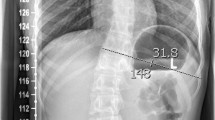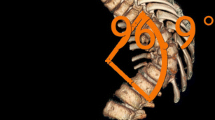Abstract
Purpose
To investigate the accuracy and reliability of the Cobb angle, the spinous process angle (SPA), and apical vertebral rotation (AVR) for measuring adolescent idiopathic scoliosis (AIS), and to evaluate the correlations between these measurements.
Methods
A retrospective study of two sets of standing posteroanterior radiographs of patients with AIS was performed. The first set was 59 consecutive patients with AIS with Cobb angles <45° and the second set was 25 patients with Cobb angles >45°. The Cobb angle, SPA and AVR of each curve was measured twice by three observers with varying measurement experience. The mean absolute difference, standard deviation, and intra- and inter-rater reliability coefficients for each measurement were examined. The Pearson correlation coefficients between any two parameters were reported. The association of the Cobb angle with the SPA and AVR was examined using a multiple regression model.
Results
The average intra- and inter-observer reliabilities (ICC [2, 1]) of the Cobb angle, SPA, and AVR were 0.99, 0.95, 0.92 and 0.98, 0.88, 0.83, respectively. The correlation coefficients (r) between Cobb angle and SPA, Cobb angle and AVR, and SPA and AVR were 0.93, 0.68, and 0.60, respectively. Using multiple regression, the association between the Cobb angle and SPA combined with AVR was R 2 = 0.90. The resulting regression model was: \({\text{Cobb angle}} = 4.1 + 0.88 \times {\text{SPA}} + 0.44 \times {\text{AVR}}\).
Conclusion
The SPA has high correlation with the Cobb angle. Including the AVR as an additional factor in multiple regression improves the prediction of the Cobb angle.

Similar content being viewed by others
References
Cobb JR (1948) Outline for the study of scoliosis. Am Acad Othop Surg Inst Course Lect 5:261–275
Herzenberg JE, Waanders NA, Closkey RF et al (1990) Cobb angle versus spinous process angle in adolescent idiopathic scoliosis. The relationship of the anterior and posterior deformities. Spine 15(9):874–879
Illes T, Somoskeoy S (2013) Comparison of scoliosis maesurements based on three-dimensional vertebra vectors and conventional two-dimensional measurements: advantages in evaluation of prognosis and surgical results. Eur Spine J 22(6):1255–1263
Lam GC, Hill DL, Le LH et al (2008) Vertebral rotation measurement: a summary and comparison of common radiographic and CT methods. Scoliosis 3:16
Li M, Cheng J, Ying M et al (2010) Application of 3-D ultrasound in assisting the fitting procedure of spinal orthosis to patients with adolescent idiopathic scoliosis. Stud Health Technol Inform 158:34–37
Li M, Cheng J, Ying M et al (2012) Could clinical ultrasound improve the fitting of spinal orthosis for the patients with AIS? Eur Spine J 21(10):1926–1935
Lonstein JE (1994) Adolescent idiopathic scoliosis. Lancet 344:1407–1412
Lonstein JE, Carlson JM (1984) The prediction of curve progression in untreated idiopathic scoliosis during growth. J Bone Joint Surg (Am) 66(7):1056–1060
Malfair D, Flemming AK, Cvorak MF et al (2010) Radiographic evaluation of scoliosis: review. Am J Roentgenol 194(3):S8–S22
Morrissy RT, Goldsmith GS, Hall EC et al (1990) Measurement of the Cobb angle on radiographs of patients who have scoliosis. Evaluation of intrinsic error. J Bone Joint Surg (Am) 72(3):320–327
Pruijs JEH, Hageman MAPE, Keessen W et al (1994) Variation in Cobb angle measurements in scoliosis. Skeletal Radiol 23(7):517–520
Stokes IA, Bigalow LC, Moreland MS (1986) Measurement of axial rotation of vertebrae in scoliosis. Spine 11(3):213–218
Stokes IA (1989) Axial rotation component of thoracic scoliosis. J Orthop Res 7(5):702–708
Suzuki S, Yamamuro T, Shimizu K et al (1989) Ultrasound measurement of vertebral rotation in idiopathic scoliosis. J Bone Joint Surg (Br) 71(2):252–255
Vieira RR, Arora R, Schweitzer ME (2009) Radiologic imaging of spinal deformities. In: Errico TJ, Lonner BS, Moulton AW (eds) Surgical management of spinal deformities, 1st edn. Elsevier, Philadelphia, pp 45–59
Villemure A, Aubin CE, Grimard G et al (2001) Progression of vertebral and spinal three-dimensional deformities adolescent idiopathic scoliosis. Spine 26(20):2244–2250
Zhang J, Lou E, Hill DL et al (2010) Computer-aided assessment of scoliosis on posteroanterior radiographs. Med Biol Eng Comput 48:185–195
Acknowledgments
This study was supported through funding provided by Natural Sciences and Engineering Research Council of Canada. The software used in this study to analyze digital radiographs was developed by Duc V. Nguyen, Department of Surgery, University of Alberta, Edmonton, AB T6G 2R3, Canada.
Conflict of interest
The authors declare that they do not have any conflict of interest.
Author information
Authors and Affiliations
Corresponding author
Rights and permissions
About this article
Cite this article
Morrison, D.G., Chan, A., Hill, D. et al. Correlation between Cobb angle, spinous process angle (SPA) and apical vertebrae rotation (AVR) on posteroanterior radiographs in adolescent idiopathic scoliosis (AIS). Eur Spine J 24, 306–312 (2015). https://doi.org/10.1007/s00586-014-3684-1
Received:
Revised:
Accepted:
Published:
Issue Date:
DOI: https://doi.org/10.1007/s00586-014-3684-1




